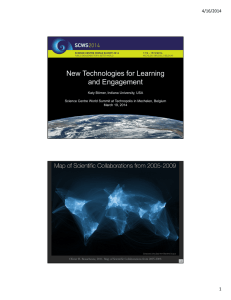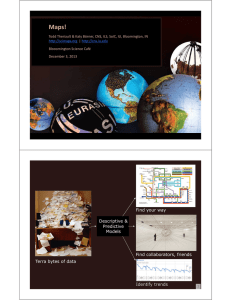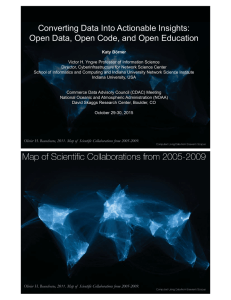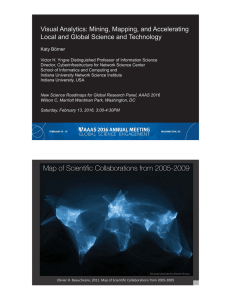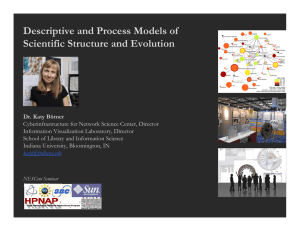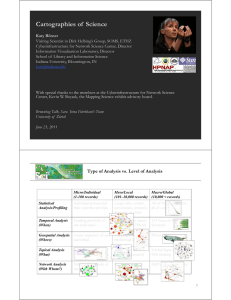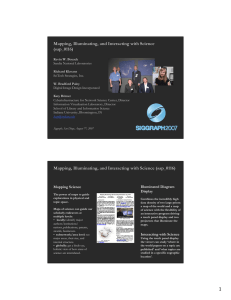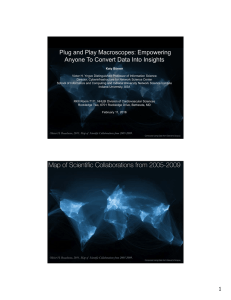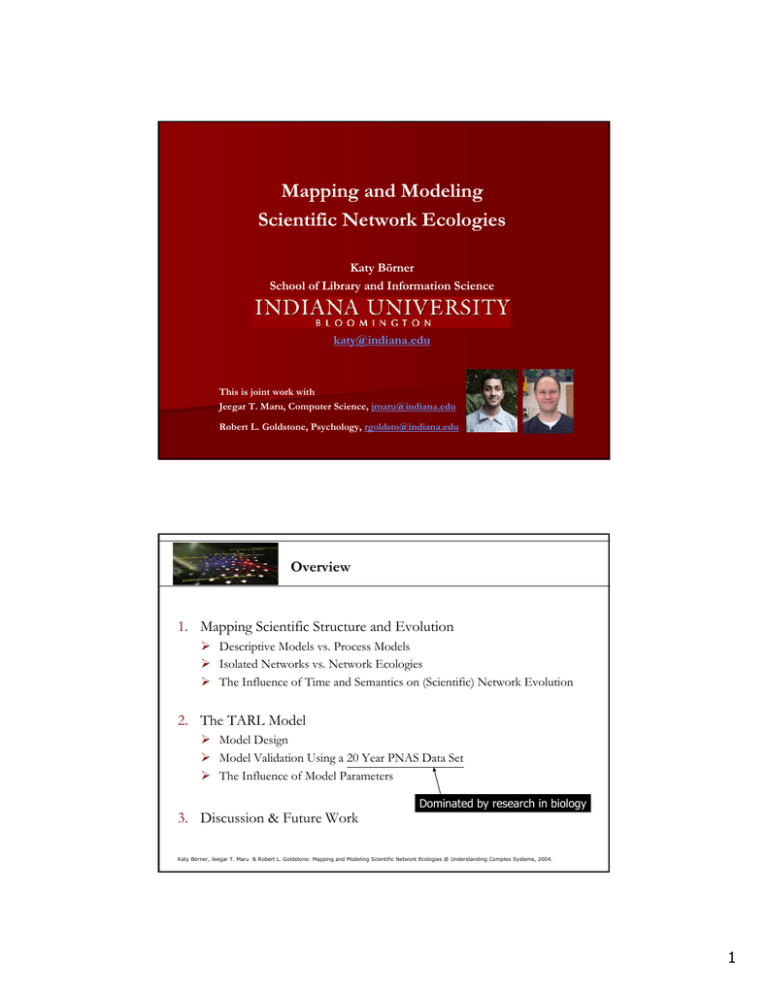
Mapping and Modeling
Scientific Network Ecologies
Katy Börner
School of Library and Information Science
katy@indiana.edu
This is joint work with
Jeegar T. Maru, Computer Science, jmaru@indiana.edu
Robert L. Goldstone, Psychology, rgoldsto@indiana.edu
Overview
1. Mapping Scientific Structure and Evolution
¾ Descriptive Models vs. Process Models
¾ Isolated Networks vs. Network Ecologies
¾ The Influence of Time and Semantics on (Scientific) Network Evolution
2. The TARL Model
¾ Model Design
¾ Model Validation Using a 20 Year PNAS Data Set
¾ The Influence of Model Parameters
3. Discussion & Future Work
Dominated by research in biology
Katy Börner, Jeegar T. Maru & Robert L. Goldstone: Mapping and Modeling Scientific Network Ecologies @ Understanding Complex Systems, 2004.
1
1. Mapping Scientific Structure and Evolution
To answer questions such as:
¾ What are the major research areas, experts, institutions, regions, nations, grants,
publications, journals in xx research?
¾ Which areas are most insular?
¾ What are the main connections for each area?
¾ What is the relative speed of areas?
¾ Which areas are the most dynamic/static?
¾ What new research areas are evolving?
¾ Impact of xx research on other fields?
¾ How does funding influence the number and quality of publications?
Answers are needed by funding agencies, companies, and us researchers.
Katy Börner, Jeegar T. Maru & Robert L. Goldstone: Mapping and Modeling Scientific Network Ecologies @ Understanding Complex Systems, 2004.
Historiograph of DNA Development
(Garfield, Sher, & Torpie, 1964)
Direct or strongly implied citation
Indirect citation
Katy Börner, Jeegar T. Maru & Robert L. Goldstone: Mapping and Modeling Scientific Network Ecologies @ Understanding Complex Systems, 2004.
2
Visualizing Science by Citation Mapping
(Small, 1999)
Katy Börner, Jeegar T. Maru & Robert L. Goldstone: Mapping and Modeling Scientific Network Ecologies @ Understanding Complex Systems, 2004.
Co-author Networks
(Newman, 2001)
Katy Börner, Jeegar T. Maru & Robert L. Goldstone: Mapping and Modeling Scientific Network Ecologies @ Understanding Complex Systems, 2004.
3
Cartographic Information Visualization
(Skupin, 2002)
Katy Börner, Jeegar T. Maru & Robert L. Goldstone: Mapping and Modeling Scientific Network Ecologies @ Understanding Complex Systems, 2004.
(Skupin, 2002)
Katy Börner, Jeegar T. Maru & Robert L. Goldstone: Mapping and Modeling Scientific Network Ecologies @ Understanding Complex Systems, 2004.
4
Indicator-Assisted Evaluation and Funding of Research
Visualizing the influence of grants on the number and citation counts of research papers (Boyack & Börner, 2003)
Katy Börner, Jeegar T. Maru & Robert L. Goldstone: Mapping and Modeling Scientific Network Ecologies @ Understanding Complex Systems, 2004.
Information Diffusion Patterns
Does the Internet lead to more global citation patterns, i.e., more citation links between papers
produced at geographically distant research instructions?
20 Year PNAS data set
Top 500 most highly
cited U.S. institutions.
Each institution is
assumed to produce
and consume
information.
Citation linkages
between institutions
fall off with increasing
distance between them.
Katy Börner, Jeegar T. Maru & Robert L. Goldstone: Mapping and Modeling Scientific Network Ecologies @ Understanding Complex Systems, 2004.
5
Mapping Topic Bursts in PNAS
(Mane & Börner, 2004)
Co-word space of
the top 50 highly
frequent and
bursty words used
in the top 10%
most highly cited
PNAS
publications in
1982-2001.
Katy Börner, Jeegar T. Maru & Robert L. Goldstone: Mapping and Modeling Scientific Network Ecologies @ Understanding Complex Systems, 2004.
a) Descriptive Models vs. Process Models
Descriptive Models
Aim to describe the major features of a (typically static) data set, e.g., statistical
patterns of article citation counts, networks of citations, individual differences in
citation practice, the composition of knowledge domains, and the identification of
research fronts as indicated by new but highly cited papers.
Bibliometrics, Scientometrics, or KDVis
Process Models
Aim to simulate, statistically describe, or formally reproduce the statistical and
dynamic characteristics of interest. Of particular interest are models that “conform to
the measured data not only on the level where the discovery was originally made but also at the
level where the more elementary mechanisms are observable and verifiable” (Willinger,
Govindan, Jamin, Paxson, & Shenker, 2002, p.2575).
Statistical Physics and Sociology
Katy Börner, Jeegar T. Maru & Robert L. Goldstone: Mapping and Modeling Scientific Network Ecologies @ Understanding Complex Systems, 2004.
6
Process Models
Can be used to predict the effects of
¾ Different publishing mechanisms, e.g., E-journals vs. books on co-authorship,
speed of publication, etc.
¾ Large collaborations vs. single author research on information diffusion.
¾ Interdisciplinary collaboration on the amount of duplication or the quality of
(deep) science.
¾ Many small vs. few large grant on # publications, Ph.D. students, etc.
¾ …
In general, process model provide a means to analyze the structure and
dynamics of science – to study science using the scientific methods of science as
suggested by Derek J. deSolla Price about 40 years ago.
We now do have the data, code and compute power to do this!
Katy Börner, Jeegar T. Maru & Robert L. Goldstone: Mapping and Modeling Scientific Network Ecologies @ Understanding Complex Systems, 2004.
Process Models
In Sociology, several mathematical models of network evolution have been
developed (Banks & Carley, 95). Most assume a fixed number of edges.
Snijders’ Simulation Investigation for Empirical Network Analysis (SIENA)
(http://stat.gamma.rug.nl/snijders/siena.html) is a probabilistic model for the
evolution of social networks. It assumes a directed graph with a fixed set of
actors/nodes.
Recent work in Statistical Physics aims to design models and analytical tools to
analyze the statistical mechanics of topology and dynamics of real world networks.
Of particular interest is the identification of elementary mechanisms that lead to
the emergence of small-world (Albert & Barabási, 2002; Watts, 1999) and scale free
network structures (Barabási, Albert, & Jeong, 2000). The models assume nodes of
one type (e.g., web page, paper, author).
Katy Börner, Jeegar T. Maru & Robert L. Goldstone: Mapping and Modeling Scientific Network Ecologies @ Understanding Complex Systems, 2004.
7
Models for Evolving Networks
Excellent Review Articles
• Albert & Barabási (2002). Statistical mechanics of complex networks.
• Dorogovtsev, S. N., & Mendes, J. F. F. (2002). Evolution of networks.
• Newman, M. E. J. (2001). Scientific collaboration networks. I. Network
construction and fundamental results.
• Newman, M. E. J. (2001). Scientific collaboration networks. II. Shortest paths,
weighted networks, and centrality.
Scale Free Networks are typically simulated by processes of incremental growth,
rewiring, and preferential attachment.
Katy Börner, Jeegar T. Maru & Robert L. Goldstone: Mapping and Modeling Scientific Network Ecologies @ Understanding Complex Systems, 2004.
Preferential Attachment
Preferential attachment supports a rich get richer phenomenon also known as the
Mathew effect (Merton, 1973), or cumulative advantage (Price, 1976).
¾ Papers with many citations will attract even more citations …
¾ Authors with many co-authors will attract even more co-authors …
¾ Authors with many papers will produce even more papers …
Preferential attachment models link (new) papers/authors to highly connected
(cited) papers/authors.
But, even experts in a field do not have an overview of the connectivity of
papers and/or authors. Each author interacts directly only with a rather limited
number of other authors and papers and makes local decisions based on his/her
position in the author-paper network.
Katy Börner, Jeegar T. Maru & Robert L. Goldstone: Mapping and Modeling Scientific Network Ecologies @ Understanding Complex Systems, 2004.
8
b) Isolated Networks vs. Network Ecologies
Food Web
(Williams & Martinez, 2000)
Internet
(Faloutsos, 1999)
Co-Authorship
(Newman, 2001)
Sex Web
Metabolic Networks
Paper Citations
(Jeong, et al., 2000)
(Redner, 1998)
(Liljeros
et al., 2001)
Katy Börner, Jeegar T. Maru & Robert L. Goldstone: Mapping and Modeling Scientific Network Ecologies @ Understanding Complex Systems, 2004.
Network Ecologies
Most real world networks exist within a delicate ecology of networks.
Authors
Co-authoring Ph.D. Students
Papers
Grants
To fully understand, e.g., the knowledge diffusion among authors via their papers,
different networks need to be considered simultaneously. Here we will concentrate
on co-author and paper-citation networks.
Katy Börner, Jeegar T. Maru & Robert L. Goldstone: Mapping and Modeling Scientific Network Ecologies @ Understanding Complex Systems, 2004.
9
c) The Influence of Time and Semantics
Aging
is an antagonistic force to preferential attachment. Even highly connected nodes
typically stop receiving links after time has passed.
Aging cluster papers and authors temporally.
Topics
By dividing science into separate fields, the global rich-get-richer effect is broken
down into many local rich-get-richer effects, leading to a more egalitarian
distribution of received citations.
Topics cluster papers and authors semantically.
Katy Börner, Jeegar T. Maru & Robert L. Goldstone: Mapping and Modeling Scientific Network Ecologies @ Understanding Complex Systems, 2004.
2. The TARL Model (Topics, Aging, and Recursive Linking)
The TARL model incorporates
¾ A partitioning of authors and papers into topics,
¾ Aging, i.e., a bias for authors to cite recent papers, and
¾ A tendency for authors to cite papers cited by papers that they have read
resulting in a rich get richer effect.
The model attempts to capture the roles of authors and papers in the production,
storage, and dissemination of knowledge.
Börner, Katy, Maru, and Jeegar Goldstone, Robert. (2004) The Simultaneous Evolution of Author and
Paper Networks. PNAS, 101(Suppl_1):5266-5273. Also available as cond-mat/0311459.
Katy Börner, Jeegar T. Maru & Robert L. Goldstone: Mapping and Modeling Scientific Network Ecologies @ Understanding Complex Systems, 2004.
10
The TARL Model: Basic Assumptions
¾
¾
¾
¾
¾
Co-author and paper-citation networks co-evolve.
Authors come and go.
Papers are forever.
Only authors that are 'alive' are able to co-author.
All existing (but no future) papers can be cited.
¾ Information diffusion occurs directly via co-authorships and indirectly via the
consumption of other authors’ papers.
¾ Preferential attachment is modeled as an emergent property of the elementary,
local networking activity of authors reading and citing papers, but also the
references listed in papers. Analogously, authors may consider collaborating with co-authors of their co-authors,
linking to web pages linked from web pages they read, etc.
Katy Börner, Jeegar T. Maru & Robert L. Goldstone: Mapping and Modeling Scientific Network Ecologies @ Understanding Complex Systems, 2004.
The TARL Model: Run & Validation
Input
Script
Model
Simulated
Networks
Model
Validation
Simple Statistics
Network Properties
N, <k>, l, C , γ
PNAS Data Set
Subsequently, I will give an intuitive explanation of the modeling process, an
explanation for engineers, one for computer scientists, as well as formulas for
math/physics folks.
Katy Börner, Jeegar T. Maru & Robert L. Goldstone: Mapping and Modeling Scientific Network Ecologies @ Understanding Complex Systems, 2004.
11
The TARL Model: Initialization
Input Script
¾
¾
¾
Parameters (topics, co-authors, reference path length, aging function)
# papers, #authors, # topics, aging function
# years, papers consumed (referenced) per paper, # papers produced per
author each year, # co-author(s) per author, # levels references are
considered, age of authors, the number of their active years, and the increase
in the number of authors over the years.
Example:
5 authors, 5 papers, no topics
Each paper has a randomly selected
set of authors but no references.
Katy Börner, Jeegar T. Maru & Robert L. Goldstone: Mapping and Modeling Scientific Network Ecologies @ Understanding Complex Systems, 2004.
The TARL Model: Sample Input Script File
------------------------------------------Model Parameters (0=without, 1=with)
------------------------------------------0
Topics
0
Co-Authors
0
Consider References
0
Aging Function
------------------------------------------Model Initialization Values
------------------------------------------2
# Years
5
# Authors in Start Year
5
# Papers in Start Year
2
# Papers Consumed (Referenced) per Paper
1
# Papers Produced per Author each Year
5
# Topics
1
# Co-Author(s) per Author
1
# Levels References are Considered
Not shown are parameters that
define the age of authors, the
number of their active years,
and the increase in the number
of authors over the years.
Katy Börner, Jeegar T. Maru & Robert L. Goldstone: Mapping and Modeling Scientific Network Ecologies @ Understanding Complex Systems, 2004.
12
The TARL Model: Pseudo Code
Katy Börner, Jeegar T. Maru & Robert L. Goldstone: Mapping and Modeling Scientific Network Ecologies @ Understanding Complex Systems, 2004.
The TARL Model: Sample Input Script File
------------------------------------------Model Parameters (0=without, 1=with)
------------------------------------------0
Topics
0
Co-Authors
0
Consider References
0
Aging Function
------------------------------------------Model Initialization Values
------------------------------------------2
# Years
5
# Authors in Start Year
5
# Papers in Start Year
2
# Papers Consumed (Referenced) per Paper
1
# Papers Produced per Author each Year
5
# Topics
1
# Co-Author(s) per Author
1
# Levels References are Considered
Katy Börner, Jeegar T. Maru & Robert L. Goldstone: Mapping and Modeling Scientific Network Ecologies @ Understanding Complex Systems, 2004.
13
Example
Year 0 - Initialization
Year 2
Initial setup, first year, and second year topology
of a simple author-paper network.
Year 1
Authors a1, a2 ,… are represented by blue circles
Papers 1, 2, … are denoted by red triangles
Red arrows indicate the information flow (via citation links)
from older papers to more recent papers.
Green arrows denote consumed and produced paper-author
relationships.
Arrows denote flow of information.
Katy Börner, Jeegar T. Maru & Robert L. Goldstone: Mapping and Modeling Scientific Network Ecologies @ Understanding Complex Systems, 2004.
The TARL Model: Sample Input Script File
------------------------------------------Model Parameters (0=without, 1=with)
------------------------------------------0/1
Topics
0/1
Co-Authors
0/1
Consider References
0
Aging Function
------------------------------------------Model Initialization Values
------------------------------------------2
# Years
5
# Authors in Start Year
5
# Papers in Start Year
2
# Papers Consumed (Referenced) per Paper
1
# Papers Produced per Author each Year
5
# Topics
1
# Co-Author(s) per Author
1
# Levels References are Considered
Katy Börner, Jeegar T. Maru & Robert L. Goldstone: Mapping and Modeling Scientific Network Ecologies @ Understanding Complex Systems, 2004.
14
The TARL Model: The Effect of Parameters
(0000)
00)
10) - Co-Authors
(1000) Topics
(100) - Topics
(001) - Reading References
(0100) Co-Authors
Topics lead to disconnected networks.
(0010) References
Co-authoring leads to fewer papers.
Katy Börner, Jeegar T. Maru & Robert L. Goldstone: Mapping and Modeling Scientific Network Ecologies @ Understanding Complex Systems, 2004.
The TARL Model: Reading References
Init + 2 year paper citation networks
without considering references (0000)
with reading references (0010)
Katy Börner, Jeegar T. Maru & Robert L. Goldstone: Mapping and Modeling Scientific Network Ecologies @ Understanding Complex Systems, 2004.
15
The TARL Model: Aging Function
Citation probability functions
observed in paper citation networks
can be fit by a Weibull distribution
of the form
140000
⎛ t ⎞a
−⎜ ⎟
−a (a−1) ⎝ b ⎠
W (t) = cab t
e
where c is a scaling factor, a controls
the variability of distribution, and b
controls the rightward extension of
the curve.
Number of Citations
120000
b=1
100000
b=3
80000
b=5
60000
b=7
b=40
40000
20000
0
1
4
7 10 13 16 19 22 25 28 31 34 37 40 43 46
Ye ars Since Publication
Katy Börner, Jeegar T. Maru & Robert L. Goldstone: Mapping and Modeling Scientific Network Ecologies @ Understanding Complex Systems, 2004.
The TARL Model:
Probability of Receiving Citations
If references as well as aging are considered, then the probability of Paper y being
cited, P(y), corresponds to the normalized sum of the aging dependent probability
n
for each of its tokens,
∑ ∑W (t )
P(y) =
t=1 i∈Pr ,t ∧i= y
n
∑ ∑W (t )
t=1 i∈Pr ,t
where n is the total number of years considered.
Hence a paper that was published in Year y and received 4 citations in Year y+1
and 2 citations in Year y+2 has 7 tokens that are weighted by the probability value
for each year.
Katy Börner, Jeegar T. Maru & Robert L. Goldstone: Mapping and Modeling Scientific Network Ecologies @ Understanding Complex Systems, 2004.
16
The TARL Model: Validation
The properties of the networks generated by this model are validated
against a 20-year data set (1982-2001) of documents of type article published in the
Proceedings of the National Academy of Science (PNAS) – about
106,000 unique authors, 472,000 co-author links, 45,120 papers cited within
the set, and 114,000 citation references within the set.
Katy Börner, Jeegar T. Maru & Robert L. Goldstone: Mapping and Modeling Scientific Network Ecologies @ Understanding Complex Systems, 2004.
The TARL Model: Validation
Young papers did not garner
many citations yet.
Katy Börner, Jeegar T. Maru & Robert L. Goldstone: Mapping and Modeling Scientific Network Ecologies @ Understanding Complex Systems, 2004.
17
PNAS Simulation Input Script File
------------------------------------------Model Parameters (0=without, 1=with)
------------------------------------------0
Topics
1
Co-Authors
1
Consider References
1
Aging Function (Weibull with b=3)
------------------------------------------Model Initialization Values
------------------------------------------21
# Years
First year
4809 # Authors in Start Year
1624 # Papers in Start Year
392
# Additional Authors per Year
3
# Papers Referenced per Paper
1
# Papers Produced per Author each Year
4
# Co-Authors
1
# Levels References are Considered
is used for initialization
Katy Börner, Jeegar T. Maru & Robert L. Goldstone: Mapping and Modeling Scientific Network Ecologies @ Understanding Complex Systems, 2004.
Comparison PNAS & SIM
Total number of papers (#p), authors (#a), received citations (#c)
and references (#r) for years 1982 through 2001.
Figure 7: Total number of papers (#p) and authors (#a) for years 1982 through 2001.
The growing average number of references and received citations is displayed in Figure 8.
Katy Börner, Jeegar T. Maru & Robert L. Goldstone: Mapping and Modeling Scientific Network Ecologies @ Understanding Complex Systems, 2004.
18
Network Properties
For undirected co-author networks, the in-degree of a node
equals its out-degree and hence the exponents for both
Source:
distributions are identical. For directed paper citation networks,
Albert, R., & Barabási,the
A.-L.
(2002).ofStatistical
mechanics
of complex
networks.
number
references
is rather
small and
constant.
Only
the47-97.
in-degree distribution (received citations) are considered.
Reviews of Modern Physics,
74(1),
Katy Börner, Jeegar T. Maru & Robert L. Goldstone: Mapping and Modeling Scientific Network Ecologies @ Understanding Complex Systems, 2004.
Power Law Distribution Exponents
Citation Distribution of PNAS Article Data
Citation Distribution of Simulated Data
12
10
10
SIM PNAS 3 refs
With 100 topics
8
ln(frequ)
8
6
6
4
4
2
2
0
0
-2
Observed
-4
Observed
Linear
-2
-1
0
1
2
3
4
5
6
ln(ncited)
Linear
-1
0
1
2
3
4
5
6
ln(ncited)
If topics are considered, the distribution shows the
b1 systematic
Rsq
d.f.
Ffrom
Sigf
same
deviations
a powerb0law asb1
.877
70 497.88 .000 10.2251 -2.2978
.842
1572.51
.000 The
9.5196
-2.054
observed for
PNAS114article
data set:
least-cited
and most-cited papers are cited less often than
predicted by a power-law, and the moderately-cited
Katy Börner, Jeegar T. Maru & Robert L. Goldstone: Mapping and Modeling Scientific Network Ecologies @ Understanding Complex Systems, 2004.
papers are cited more often than predicted.
Rsq
d.f.
F
Sigf
b0
19
Power Law with Exponential Cutoff
provides a better fit
Networks in which aging occurs, e.g., actor networks or friendship networks, show
a connectivity distribution that has a power law regime followed by an exponential
or Gaussian decay or have an exponential or Gaussian connectivity distribution
(Amaral et al., 2000). Newman showed that connectivity distributions of co-author
networks can be fitted by a power-law form with an exponential cutoff (Newman,
2001c).
Following this lead, we fit a power law with exponential cutoff of the form
x
−B C
f (x) = Ax e
This function provided an excellent fit to the PNAS paper citation network with
values of A=13,652, B= .49, and C=4.21 (R2=1.00).
Katy Börner, Jeegar T. Maru & Robert L. Goldstone: Mapping and Modeling Scientific Network Ecologies @ Understanding Complex Systems, 2004.
The TARL Model: Influence of Parameters
Topics: The number of topics is linearly correlated with the clustering coefficient of the
resulting network: C= 0.000073 * #topics. Increasing the number of topics increases the
power law exponent as authors are now restricted to cite papers in their own topics area.
Aging: With increasing b, and hence increasing the number of older papers cited as references,
the clustering coefficient decreases. Papers are not only clustered by topic, but also in time, and
as a community becomes increasingly nearsighted in terms of their citation practices, the
degree of temporal clustering increases.
References/Recursive Linking: The length of the chain of paper citation links that is
followed to select references for a new paper also influences the clustering coefficient.
Temporal clustering is ameliorated by the practice of citing (and hopefully reading!) the papers
that were the earlier inspirations for read papers.
Katy Börner, Jeegar T. Maru & Robert L. Goldstone: Mapping and Modeling Scientific Network Ecologies @ Understanding Complex Systems, 2004.
20
3. Discussion & Future Work
¾ TARL model grows author and paper networks simultaneously.
¾ Uses the reading and citing of paper references as a grounded mechanism to
simulate preferential attachment.
¾ The number of topics is linearly correlated with the clustering coefficient of
the resulting network and can be determined from the cluster coefficient
observed in real world networks.
¾ The model incorporates aging, i.e., a bias for authors to cite recent papers and
hence papers are not only clustered by topic, but also in time.
For the sake of simplicity we fixed the number of papers produced by each author
per year and fixed the number of co-authors. To model the rich get richer effect
for co-author networks, recursive linking can be applied so that authors coauthor with co-authors of their co-authors.
Clearly, further validation of the model with different parameter settings and
other data sets is necessary.
Katy Börner, Jeegar T. Maru & Robert L. Goldstone: Mapping and Modeling Scientific Network Ecologies @ Understanding Complex Systems, 2004.
Modeling and Studying Feedback Cycles in Network Ecologies
The productivity of an author may depend not only from his/her position in the
author-paper network but also on research funds, facilities, and students. Hence,
grant support will be modeled as a third network to capture the positive feedback
cycle observed in real world network ecologies.
Authors
Co-authoring Ph.D. Students
Papers
Grants
Network Structure & Network Usage
In how far does the usage of a network (e.g., via search engines) influence its
structure?
Visualizing the Evolution of Scientific Fields and Knowledge Diffusion
How to map the structure and evolution of all of science.
Katy Börner, Jeegar T. Maru & Robert L. Goldstone: Mapping and Modeling Scientific Network Ecologies @ Understanding Complex Systems, 2004.
21
Acknowledgements
This work greatly benefited from discussions with and comments from Kevin
Boyack, Albert-László Barabási, Mark Newman, Olaf Sporns, Filippo Menczer,
and the anonymous reviewers. Mark Newman made code available to determine
the small world properties of networks. Nidhi Sobti was involved in the analysis of
the influence of model parameter values. Batagelj & Mrvar’s Pajek program was
used to generate the network layouts.
This work is supported by a National Science Foundation CAREER Grant under
IIS-0238261 to the first author, and a National Science Foundation grant 0125287
to the third author.
The data used in this paper was extracted from Science Citation Index Expanded –
the Institute for Scientific Information®, Inc. (ISI®), Philadelphia, Pennsylvania,
USA: © Copyright Institute for Scientific Information®, Inc. (ISI®). All rights
reserved. No portion of this data set may be reproduced or transmitted in any
form or by any means without prior written permission of the publisher.
Katy Börner, Jeegar T. Maru & Robert L. Goldstone: Mapping and Modeling Scientific Network Ecologies @ Understanding Complex Systems, 2004.
InfoVis CyberInfrastructure
Katy Börner, Jeegar T. Maru & Robert L. Goldstone: Mapping and Modeling Scientific Network Ecologies @ Understanding Complex Systems, 2004.
22
InfoVis Software
Web Site: http://iv.slis.indiana.edu/sw
Jason Baumgartner, Katy Börner, Nathan J. Deckard, Nihar
Sheth. An XML Toolkit for an Information Visualization
Software Repository. Poster Compendium, IEEE Information
Visualization Conference, pp. 72-73, 2003.
Katy Börner, Jeegar T. Maru & Robert L. Goldstone: Mapping and Modeling Scientific Network Ecologies @ Understanding Complex Systems, 2004.
Katy Börner, Jeegar T. Maru & Robert L. Goldstone: Mapping and Modeling Scientific Network Ecologies @ Understanding Complex Systems, 2004.
23
Katy Börner, Jeegar T. Maru & Robert L. Goldstone: Mapping and Modeling Scientific Network Ecologies @ Understanding Complex Systems, 2004.
Katy Börner, Jeegar T. Maru & Robert L. Goldstone: Mapping and Modeling Scientific Network Ecologies @ Understanding Complex Systems, 2004.
24
Katy Börner, Jeegar T. Maru & Robert L. Goldstone: Mapping and Modeling Scientific Network Ecologies @ Understanding Complex Systems, 2004.
Katy Börner, Jeegar T. Maru & Robert L. Goldstone: Mapping and Modeling Scientific Network Ecologies @ Understanding Complex Systems, 2004.
25
Katy Börner, Jeegar T. Maru & Robert L. Goldstone: Mapping and Modeling Scientific Network Ecologies @ Understanding Complex Systems, 2004.
XML Toolkit
Katy Börner, Jeegar T. Maru & Robert L. Goldstone: Mapping and Modeling Scientific Network Ecologies @ Understanding Complex Systems, 2004.
26
ANALYSIS ALGORITHMS
generate models from parsing other data
structures and/or processing on the data
LAYOUT ALGORITHMS
run graphical processes on the
appropriate model
DATA MODEL PERSISTENCE
factory to persist a model to a particular
data store (i.e. XML format, database)
STANDARD MODEL INTERFACES
based on Java 2 Swing standard models
CODE INTEGRATION
new algorithms can be easily integrated by
supporting one or more of the models
Katy Börner, Jeegar T. Maru & Robert L. Goldstone: Mapping and Modeling Scientific Network Ecologies @ Understanding Complex Systems, 2004.
Framework can run different
data analysis and IV
algorithms on a standard set
of input data formats (tree,
matrix, network, table, list).
Models from the algorithms
can be serialized through the
persistence layer; and it is
generic enough for plugging
in various persistence options
(XML, SQL database, etc).
Based on Model-ViewController (MVC) by
focusing on standard data
model interfaces for data
exchange.
Katy Börner, Jeegar T. Maru & Robert L. Goldstone: Mapping and Modeling Scientific Network Ecologies @ Understanding Complex Systems, 2004.
27

